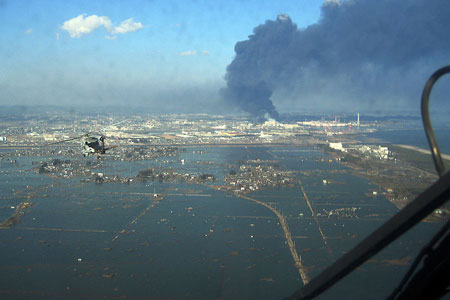The Fukushima disaster caused serious ocean contamination
The Fukushima I plant incident was devastated by tsunamis / earthquakes in March, pouring a lot of cesium 137 into the sea and this is the biggest oceanic nuclear radiation pollution ever - Nuclear Safety Institute of France (IRSN) concluded.
According to research recently published by IRSN, from March 21 to mid-July, there were 27,1 peta bequerels of cesium 137 radioactive material flowing into the sea. (Peta bequerel is a unit of radioactivity. One peta becquerel is equal to one billion billion bequerels, on a scale from 1 to 15 of the scale of atomic radiation, this rank is 10th).

Japan coast after strong earthquake 9.0 caused terrible tsunami.
In the press release, IRSN said 'this is the largest human-induced nuclear radiation ever in the ocean environment . ' Fortunately, ocean currents disperse a lot of this radiation.
Calcium is an atomic element that dissolves very slowly, taking 30 years to halve its radioactivity.
In addition, IRSN also discovered that iodine 131 radioactivity has also spilled into the sea a lot, but not a major threat because it only takes 8 days to immediately reduce 50% of the activity level.
According to IRSN, even though the ocean currents dispersed cesium 137 is quite strong, its level still exists as 0.004 becquerels per liter of ocean water of the Pacific, which is twice as high as in the 1960s.
IRNS stated that it will maintain the activity of monitoring living organisms in coastal Fukushima because of the serious pollution of this sea area may even increase when the amount of radioactive seawater from the plant is damaged. continue to pour into the ocean.
On October 27, the Japan Atomic Energy Commission expert confirmed that the recovery of molten fuel of the No. 1 to No. 3 units of the Fukushima I nuclear power plant needs to be 10 years old. can start, but want to stop operating all 3 reactors need to take several decades.
- Plants mutated genes because of radiation near Fukushima
- Infected wild boar flooded Fukushima street
- Fukushima workers died not because of radiation
- Half of Fukushima children are radioactive
- Looking back on 2 years of Fukushima nuclear disaster
- Japan acknowledged the first death due to radiation at Fukushima
- Fukushima 7 years after nuclear disaster
- Accumulated contamination of Fukushima workers is still high
- Japan planted radiation-resistant sunflowers
- Fukushima radiation spreads to the US coast
- Fukushima is 'artificial disaster'
- Exotic plants after the Fukushima disaster
 Is the magnetic North Pole shift dangerous to humanity?
Is the magnetic North Pole shift dangerous to humanity? Washington legalizes the recycling of human bodies into fertilizer
Washington legalizes the recycling of human bodies into fertilizer Lightning stone - the mysterious guest
Lightning stone - the mysterious guest Stunned by the mysterious sunset, strange appearance
Stunned by the mysterious sunset, strange appearance